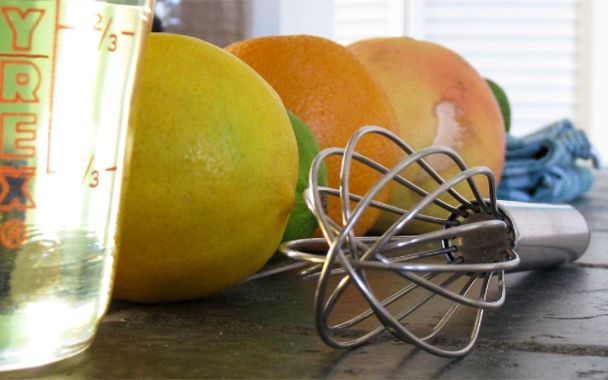Pardon the intrusion—because this is a deeply personal question—but have you ever broken an emulsion?
After some difficult emotional work, I can admit to it. I have watched my mayonnaises and hollandaises turn into greasy messes, bubbles of oil slipping out of the base while I try pathetically to whisk them back in. I have felt my arm go numb as those bubbles turn defiantly into a slick and then a pool and then a floating lake of fat. I have heard oil actually laugh at me, traumatized and emasculated.
It’s been years since I’ve broken an emulsion, but a slight terror still grips me every time I have a whisk in one hand and a bottle of oil in the other. I start beating maniacally before the oil even hits the bowl, and splash away with the devil in my eyes when it does. I felt it again the other day when I was making a citrus vinaigrette that I cribbed years ago from Higgins Restaurant in Portland, an amazing dressing that’s sharp but round, tart but lush. I’ve made it plenty of times, but it still feels especially dangerous because it has no egg yolk, whose lecithin is the magical eye of newt that keeps oil and water together.
(Oh, sure, you can get all Harold McGee and talk to me about shearing force and particle suspension in the continuous phase, but in my fear I’m going to ignore that there’s such a thing as science and just keep insisting that it’s all hocus pocus. Because I’m bitter and I’m clinging to my whisks and superstition.)
But you don’t have to be like me. You can be rational. Make this a few times and tell me how good it feels to live a life unshackled by fear.
Citrus Vinaigrette
· Take some of your favorite citrus fruits, a mix of sweet and sour ones. If you have to have an ingredient list, how about a grapefruit, a pair of lemons, a pair of limes, and a couple of oranges? Whatever turns you on.
· Zest half of the fruits and mince the zest. (Better yet, use a Microplane.)
· Squeeze the fruits mercilessly. Reduce the juice with a pinch of salt and a tablespoon of sugar. Taste it. It should be pretty tart.
· Skim off the foam that bubbles up. No, I don’t know what the hell it is either.
· When the juice is reduced enough to just barely coat the back of a spoon, taste it again and add sugar until it’s balanced. How do you know when it’s balanced? Taste it and imagine someone asking, “Hey, is that stuff sweet or sour?” It’s balanced when you say, “I can’t really tell.” Cook it until it clings a little more to the spoon. (The sugar will help with this, too.)
· Drop your zest in off the heat, let it steep for a minute, and strain the juice into a large bowl. Let it cool until it’s warm but not hot.
· Okay, you ready? Get your whisk in there and start working it while you pour in a thin stream of neutral-flavored oil. Because I’m chicken, I pour it in stages, pausing every few moments to just whisk what’s in the bowl and making sure the emulsion is sticking. If there are any oil bubbles on the surface, beat them into submission.
· How much oil? Well, is it balanced? It’s balanced when it starts off tart and sweet and then rounds out gracefully, from a pucker to a smile. If you’re not smiling yet, give it more oil.
· See? It’s easy. Now just put it in the fridge or throw it on some salad or some fish or some crab cakes or… OH GOOD GOD MAN! YOU BROKE IT! It’s okay. Breathe, and let it separate. Pour off the oil on top, save it, and throw the juice mixture in a blender. Crank it in there until the emulsion forms again, then slowly pour the oil back in. If that doesn’t work, pour off the oil again and reheat the juice with some more sugar until it coats your spoon pretty readily and try it again in the blender. And if that doesn’t work, well, I don’t know what to tell you. Take it personally, I guess.




 Pinterest
Pinterest


